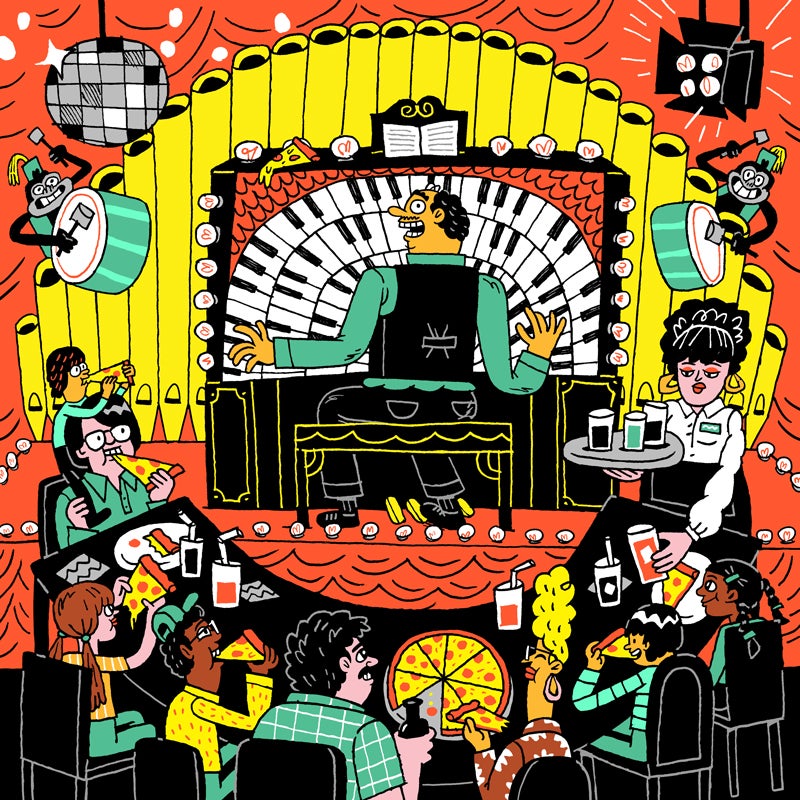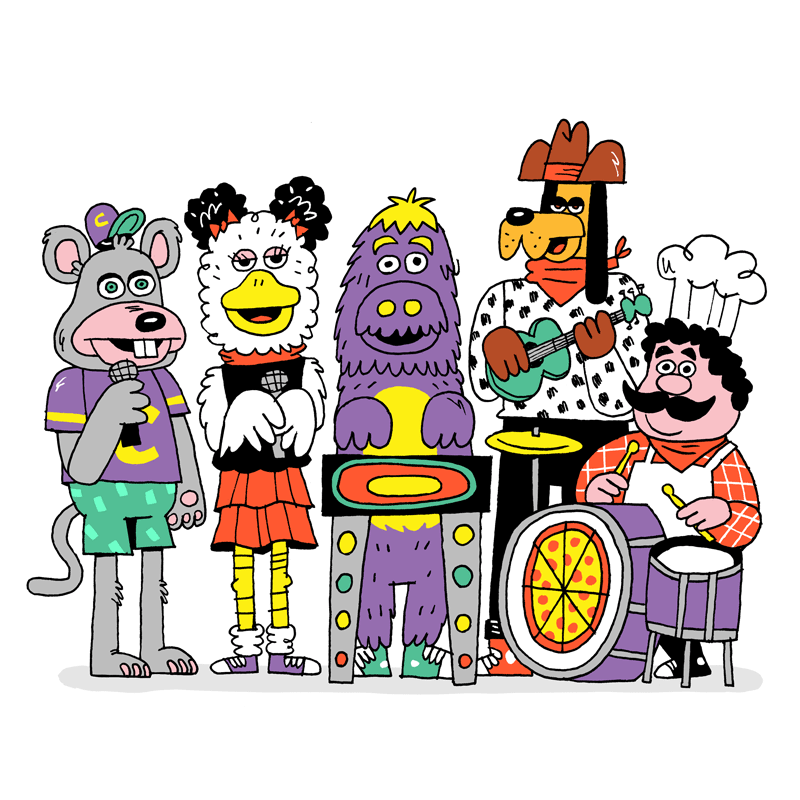what happened to the pipe organ at pizza and pipes redwood city
The Life and Death of Pizza and Pipes

Back before Chuck E. Cheese'due south and animatronics, a pizza dinner with the family unit came with a side of prog rock played on a live organ.
In the 1970s and '80s, alive pipe organ music could be heard in more than 100 pizzerias across the country. By the 1990s, they were about all extinct. Just as life began on Earth when all conditions were inconceivably correct at the verbal correct moment in time, the "pizza and pipes" phenomenon (as it came to be known) was a synergistic super squad of several seemingly disparate cultural themes that all happened to have been huge in the 1970s.
Family-friendly pizzerias were all of a sudden juxtaposed with—and inexplicably improved by—cinematic scores and synthed-out prog rock played on antique, churchy piping organs sitting right in eating place dining rooms. This was dinner theater for the whole family, from the era that brought us the children's carte and "parenting" as a substantive and social construct. This was music that miraculously sounded old and new at the same time: the jarring, futuristic sounds of the '70s, played on glorious vintage instruments from the 1920s.
Organ Grinder Pizza, in Portland, Oregon, was the first to serve me pizza that wasn't a frozen Totino'southward. Its most memorable carte du jour particular was a hamburger-topped taco pizza called the Percussion, to exist exact, and it was served under the twinkling lite of disco balls, to the euphony of live organ music. Seated on a platform in the middle of the dining room sat a gleaming, gilded organ played by the Liberace du jour, accompanied by a mechanical monkey playing the cymbals. The organ was a 4-transmission Wurlitzer with 51 ranks and nearly iv,000 pipes. There were arcade games in the dorsum of the restaurant, and gilding the lily was a hurdy-gurdy player stealing kisses from a real live capuchin monkey named Pizza Pete, who jumped around the dining room, tipping his hat to the audition members and shaking them downward for greenbacks with his lilliputian can cup.
Pipe organs had been fixtures in theaters during the silent-film era of the early 20th century, and most pipe organs in pizza joints were repurposed from old theaters—the Organ Grinder's Wurlitzer was originally located in Portland's Oriental Theater (razed in 1970). With the widespread adoption of "talkies" during the 1930s, silent films and the theater organ were finer dead. Hundreds of beautiful, perfectly functional organs spent decades hiding in theaters, waiting for their moment to once once again polish.
Meanwhile, American soldiers stationed in Italy during Globe State of war II returned with a gustatory modality for pizza. (That'southward non to say that pizza hadn't already been around in the U.S.; it came to New York with Italian immigrants in the belatedly 1800s.) In the Bronx, Baker's Pride Oven Company launched its line of commercial pizza ovens in the mid-1940s, and before long pizzerias began cropping up around the country.
Because of the crowd-friendliness of their primary offering, pizza parlors are by and large a louder blazon of restaurant. There's typically one large dining room, which lends itself well to the unsubtlety of a pipe organ. In 1962 (4 years after opening), Ye Olde Pizza Joynt in Hayward, California, was the showtime to put the two together. This coincided neatly with the nascency of dinner theater, which picked upwardly momentum in the 1960s and '70s. In the mid-1970s, the pizza-and-pipes trend spread similar fireweed; by the 1980s, there were close to 150 organ-boosted pizzerias in North America.
Organists played everything from the predictable "Toccata and Fugue in D Minor" and the jaunty ragtime stylings of Scott Joplin to thunderous renditions of "Pinball Wizard" and "Tubular Bells" (ameliorate known equally the Exorcist theme). Star Wars medleys were likewise in heavy rotation; the colorful mixtures in a tutti-heavy "Cantina Band" were always met with rapt enthusiasm. These pizzerias were then acutely popular that some of the organists even cut albums, which were sold in the restaurants.

Simply all good and pure things must die. In 1977, Atari founder Nolan Bushnell opened the first Chuck Due east. Cheese's Pizza Time Theatre in what would become the Silicon Valley, a mere 30 miles from Ye Olde Pizza Joynt. Bushnell admitted in a 2013 interview with The Atlantic that he'd gotten the idea from a pizza parlor called Pizza and Pipes and and then applied Disneyland's animatronic tech to the "pizza + entertainment = $$$" formula. Whereas pipe organs were charmingly former-fashioned, video games were newfangled tech, and anthropomorphic robo-critters were positively mind-blowing.
"Whoever coined the phrase 'fun for the whole family' obviously never had fun—and never had family," wrote marketing industry expert Jim Joseph for Entrepreneur. "You simply can't be all things to all people. There's no 'fun for the whole family unit' in marketing." But Chuck East. Cheese'south, similar many of the pizza parlors with live music, certain tried.
The lower-tier nutrient and potable program scarcely fabricated upward for the lawless hellscape of a Chuck E. Cheese's, despite the spectacle of the animatronic furries in Munch'southward Make-Believe Ring. But it seems that the kid-pandering chain may be yielding to the urge to satisfy all needs, like its predecessors did; in August of 2017 Chuck E. Cheese's announced that information technology would phase out its animatronic critter-band and effort a more parent-friendly menu.
Of the legions that one time graced the North American dining landscape, only 3 pipe organ pizzerias remain in the U.Southward.: Organ Piper Pizza in Greenfield, Wisconsin; Ragamuffin's Pizza in Lansing, Illinois; and Organ Stop Pizza in Mesa, Arizona. When Portland's Organ Grinder ran out of money and airtight in 1996—14 years after a Chuck E. Cheese opened a few blocks abroad—the organ was dismantled, with bits and pieces going to collectors effectually North America. Those behemothic diaphones went to Organ Stop Pizza in Mesa, and the building now houses an all-you-can-eat Chinese buffet.
Though its remains have been scattered beyond the country, I still periodically revisit the Organ Grinder by listening to "Over the Rainbow" while eating taco pizza. Thank you to YouTube (and my own copy of the Organ Grinder record anthology, scored on Amazon), I can always accept a dewy-eyed stroll down retentiveness lane.
Source: https://tastecooking.com/life-death-pizza-pipes/
0 Response to "what happened to the pipe organ at pizza and pipes redwood city"
Post a Comment